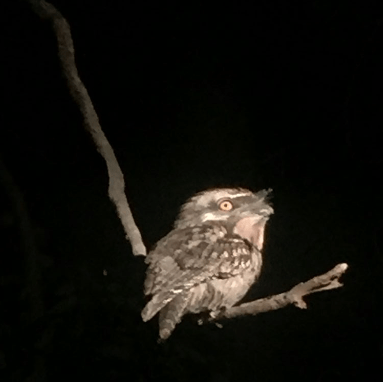Spotlighting - Conservation Biology
The feel of the wind in your face and the stars sparkling in the sky are the only backdrop. The tiny orange eyes glow in the abyss of forest that lets you know that you are not alone. Brushtail possums, woylies, and grey kangaroos move through the forest during their nighttime feeding period. The research truck wanders along at a slow 5 kilometers per hour while the two data collectors ride on the top of the truck using huge headlights to illuminate the bright eyes. When you find the glowing eyes it’s a race to get a strong ID, estimate the distance to the animal, get a direction, and if you’re lucky maybe even a picture. It’s one thing to learn about endangered marsupials and it’s another to see these creatures up close and personal in their native habitat. The look of the tawny frogmouth owl peering into the light from a branch only 3 meters away generates a sensation of awe. A native nocturnal bird that woylie researchers may take for granted is a sight that you will cherish.
Although the experience of field work such as spotlighting is amazing, the conservation research and planning that can be done with this knowledge is even greater. Populations are difficult to determine but getting a general estimate of the abundance of a species allows you to graph a trend. Over time, these trends will create a visual representation of the species as a whole. While declines of the species could be detrimental, species like the woylies can recover. Despite the fact the decline of the woylies cannot be tied to one simple factor such as foxes and feral cats predation, with multiple studies a picture of the plight of the woylies can be created with the factors such as predation, disease, habitat fragmentation, fire and possibly even climate change considered. The continuation of spotlighting and other research methods such as trapping emphasize the importance of using scientific rigor for success. Each night of spotlighting can add to the database of knowledge necessary to help the woylie population, one pair of eyes at a time.
Sarah Bryan - Eckerd College
Related Posts

Differences between US & Australian academic culture
Study abroad is meant to be different to what you are used to back home. So be prepared for differences in and out of the classroom. Academic Calendar Australia: The... keep reading

EAT, DRINK, EXPLORE: SYDNEY
BEST FOOD TO EAT IN SYDNEY While in Sydney, a stop at Black Star Pastry for a slice of their signature Strawberry Watermelon Cake is practically mandatory. The bakery opened... keep reading

Eat, Drink, Explore: Melbourne
@cieestudyabroad Eat, Drink, Explore: Melbourne, Australia Check out our NEW study abroad programs in Melbourne in our bio! #ciee #cieestudyabroad #studyabroad #melbourne #australia #eatdrinkexplore Show Me How - Men I... keep reading
